What Is SaaS Customer Support: Beyond Basics
Have you ever asked yourself, "What is SaaS customer support?" We're now ready to dive deep into a world that is much bigger than just answering the phone and texts. Customer service for SaaS (Software as a Service) is what keeps the digital service business going. They make sure that users get the most out of their software and feel like they are being heard and respected whenever they need quality technical support.

Why Is Customer Support Vital for a SaaS Company
Retention Is the Name of the Game
SaaS is a busy market where new apps come out like spring flowers. Keeping a customer is like finding a rare gem. Why? The cost of getting a new customer is much higher than the cost of keeping an old one happy. Actually, according to HuffPost, it costs 6-7 times more to convert a new customer than to retain an existing one. And when you also factor in that 51% of customers will cancel a subscription after just one bad support experience, the importance of quality tech support becomes undeniable.
The Place for Brand Ambassadors
Think about a customer who is so happy with the service they got that they can't help but shout it from the hills. These satisfied customers not only stick with you, but they become brand ambassadors, gushing about how great their experience was without you having to pay for any ads. It's the best kind of spontaneous marketing, where real happiness and kindness are at the core.
Feedback: The Breakfast of Champions
And when isn't growth the goal? Customer feedback is the filling food that keeps growth going. Every question or complaint that is handled is a chance to make things better. Think of your customer service as a busy workshop where feedback is the essential tool and constant improvement is the prized outcome. Your service will reach high heights of greatness as you listen, learn, and encourage.
Keeping an old customer is actually cheaper than getting a new one, so focus on client retention
The Evolution of Customer Support in SaaS
What Is SaaS Customer Support: From Reactive to Proactive
Remember when customer service was like a guard dog that was always sleeping and wouldn't bark until someone broke in? Those times are long gone. In the fast-paced world of SaaS, support teams have become watchful guardians, constantly scanning the sky for possible problems and taking action before they become full-blown crises. It's a change from just responding to actively preventing problems and making sure that user needs are expected and met with quick, effective answers.
Self-Service Is Growing
It's satisfying to figure things out on your own, don't you think? This fact has been fully accepted by the development of customer service, resulting in the rise of knowledge bases, frequently asked questions (FAQs), and chatbots powered by AI. With just a few clicks, these tools let users figure out their problems, turning help into a self-service menu. Customers should be able to enter the library at their own pace and be able to explore and solve problems at their own speed. This will make each exchange a journey of discovery.
It's All About Customisation.
The need for personalised customer service has become a rallying cry in a world where we're often reduced to numbers and facts. Users are tired of one-size-fits-all solutions and want experiences that recognise how unique they are. They want help that remembers their name, knows their past, and makes solutions fit their needs. This movement towards customisation has made it possible for support experiences to connect with people on a personal level. Each exchange is now a one-of-a-kind work of art, created with the user in mind.
What Is SaaS Customer Support: Key Metrics to Gauge SaaS Support Success
Response Time: The Need for Speed
Every second is important in the world of SaaS, where things move very quickly. Imagine that a person runs into a problem and asks for help. How quickly your team acts can make the difference between a small problem and a major one. Quick responses not only show that you care about your customers, but they also set the tone for the whole help conversation. As the user's satisfaction is passed from question to answer like a baton in a relay run, each tick of the clock is important.
Resolution Rate: Solving, Not Just Responding
On the other hand, speed is only one part of the game. The most important thing is to cross the finish line and solve the problem. At this point, the closure rate becomes important because it shows how well your team is fixing problems instead of just recognising them. That's the difference between a doctor who just tells you what's wrong and one who will fix it. Tracking the success rate shows you how well your support is working and makes sure that users are not only heard but also helped.
Customer Satisfaction (CSAT): The Best Way To Measure
The main point of the question "What is SaaS customer support?" is to make the customer happy. You can get direct feedback from people about how they feel about your help efforts through the CSAT score. By regularly checking and analysing CSAT numbers, you can get a real-time picture of how happy your customers are, which can help you improve the way you support them. Have a look at how maintaining these metrics within the desired figures has resulted in one of our partners to trust us for more than 14 years and going.

Future Trends: Where SaaS Support is Headed
AI and automation are spearheading the evolution of SaaS customer service
AI and Automation: The Future
A long time ago, artificial intelligence (AI) and robotics were just trendy words. They are now the engines that power a new age of SaaS customer service. Think about a world where support isn't just reactive, but also proactive, with AI and automation working hard behind the scenes to provide faster, better, and more efficient help. It's like having a team of superheroes ready to save the day at any time, even before you know there's a threat.
Omnichannel Support: Be Everywhere, Seamlessly
Today's world is very linked, and people are always checking their emails, talking on social media, and looking at websites. Omnichannel support meets people where they are and makes sure they have a smooth, unified experience across all devices. You can be a friendly neighbourhood SaaS support person who is available all over the internet and ready to help people with a smile, no matter where they are. This method makes sure that no user is forgotten, and each contact feels personal and linked.
Using Predictive Support to Fix Things Before They Break
The cool thing about predicted help is that it can see problems coming before they happen. With the help of analytics and big data, SaaS companies can now find trends, guess what problems might happen, and fix them before they happen. It's like having a crystal ball that can see problems and come up with answers before people even know there is a problem. This innovative method changes the help experience, making it truly user-centered and ground-breaking.
What Is SaaS Customer Support: Wrapping It Up
So what is SaaS customer support if not a well-balanced group of tools, technologies, and human understanding that is designed to make users happy at all times? It's clear that as SaaS businesses change, so will the ways they help customers, keep them interested, and keep them as customers.
IntelligentBee, Synonymous for Quality and Reliance
At IntelligentBee, we believe that these two factors are the best calling card. Take 5 minutes out of your time to get in touch with us and then on a chat in order to explain your needs to us. See what we can do to use our SaaS expertise to elevate your technical support reputation.
What Is Outsourcing Technical Support: Latest Trends
There are a lot of things you should know about what is outsourcing technical support. Subcontracting technical help isn't just a trend; it's a smart move for companies that want to stay ahead in the digital world. From small businesses to global conglomerates, all are using outside assistance to improve their customer service. Here's how things are changing.

The Future of Outsourced Technical Support
We land in a world where the future is not just close, it's here, and it's dazzlingly bright as we try to figure out what outsourcing technical help means. Before we talk about the newest trends, let's take a look at the shiny packages:
Beyond Borders: Talent Pools Around the World
Picture an expanse with no limits. No, not the kind you're thinking of. Think bigger and more about ability. There are now companies that work with experts from all over the world so that you can get help at any time of the day or night.
This global talent pool isn't just a way to fill seats; it's also a way to add different skills and points of view to the help experience. When you call for help the next time, keep in mind that you could be getting answers from someone in another country!
Quality and Efficiency Together
Okay, let's talk about the dream pair: quality and speed. Businesses are finding that hard-to-find balance in this golden age of outsourcing technical help. Similar to discovering nice, comfy shoes that don't break the bank.
This is what outsourcing is all about: giving great service without charging a lot. It's become clear to businesses that cutting costs doesn't mean leaving quality behind. Instead, they're making support models that are smarter and cheaper and that work great.
Unique Journeys for Each Customer
Customer service used to say "one size fits all," but those days are over. Customised trips are now the rule. That's how modern outsourced technical help makes you feel when you walk into a party that was thrown just for you.
Customers feel like they are the centre of the world because every interaction and solution is made just for them. Since, well, they are. With this personalised method, support goes from being just a service to an experience that customers love and remember.
Emerging Technologies Shaping Outsourced Support
The next thing we'll talk about is how new technologies are not only changing how we deal with outsourced support, but also making the future look like something from a science fiction book.
The Revolution in AI
To begin, let us talk about the big AI change. AI is here and making a big difference in what is outsourcing technical support and how it helps customers. It's no longer just something out of tech myths.
Suppose you are talking to someone who, in this case, is AI. That person knows your past, your preferences, and even what you need help with before you finish typing. That's AI at work—it makes customer service faster, smarter, and strangely more like a person.
Blockchain to Build Trust
Blockchain is the next tech trend we'll look at. Not only crypto fans can use it anymore. When it comes to outsourcing technical help, blockchain is the hero who makes sure that all transactions and communications are safer than Fort Knox.
Customers are more likely to trust this technology because it guarantees safety and openness. When you talk to support again, keep in mind that blockchain technology might be keeping your information as safe as a secret diary.
Help for virtual reality
Last but not least, let's put on our VR headsets and discover the world of virtual reality support. It used to be that calling someone to talk about a technical problem was like telling a dream.
But now, It's like having the customer service rep right there in your room with you as you look at the problem with VR. This isn't just help; it's an experience that blurs the lines between people and makes things easier to understand.
Global Trends in Technical Support Services
Asking "what is outsourcing technical support" leads to a world where the only thing that stays the same is change. The best ways to provide great technical help change along with the digital world we live in. Let us look at the global trends that are affecting how businesses handle tech help in a world where it is outsourced.
The Move to Cloud Services
Think about a world where tech help is as adaptable as your favourite yoga teacher. That's what moving to cloud services gives you. With cloud-based platforms and tools, technical help that is outsourced is becoming a flexible service that can be used anywhere.
This means that your customers can get help with anything, whether they are drinking tea in London or lying in the sun in Sydney. Because of how the cloud has changed how support services are delivered, accessibility and flexibility are now the rule.
Putting Data Security First
In a world where data is worth more than gold, technical support services' main goal is to keep it safe. As the saying goes, "With great power comes great responsibility." This is especially true when it comes to data security.
These days, outsourced technical support teams don't just fix problems; they also protect your data and make sure that every contact and transaction is as safe as Fort Knox. It's not just a trend to put more stress on security; it's a promise to earn and keep customer trust.
Sustainability in Help
No longer is leasing just a way to save money. Together with partners who share your ideals, especially when it comes to sustainability, today is all about getting along. Companies are looking for technical help services that are outsourced and don't hurt the environment.
Being green isn't the only reason for this move towards sustainability; it's also about making partnerships that stand for more than one thing. This move shows employees as well as clients that being efficient doesn't have to mean hurting the environment.

How AI and Automation Are Revolutionizing Outsourcing
We looked into the question "What is outsourcing technical support?" We've hit a futuristic edge where AI and automation are not just making things better, they're also changing the rules. It's like a sci-fi movie has come to life as support systems get better and more efficient. But this is happening right now in the world of technical support outsourcing. Come with me as I talk about how these new developments are changing the field.
Chatbots and Virtual Helpers
Say hello to your new digital friends, virtual helpers and chatbots. They're your first line of defence against the flood of questions that come in, thanks to the magic of AI. These bots aren't like other bots; they can understand, learn, and even feel what other people are feeling.
This makes the solving process faster and easier than ever. Imagine getting quick, correct answers at any time of the day. That's what AI is making possible in outsourced technical help.
Predictive Analytics to Help with Proactive Support
It's better to stop problems before they happen than to wait for them to happen. This is where predictive analytics comes in. It can see problems coming and fix them before they even become known to the customer.
You get practical insights that help you stop problems before they happen. It's like having a crystal ball instead of vague predictions. This proactive approach is changing the way technical help is outsourced, so services are no longer just reactive but also proactive.
Routine Tasks Can Be Automated.
When you work in technical help, time is very valuable, and doing the same things over and over again is the worst way to waste it. Here comes technology, the hero who frees people from boring tasks so they can work on more difficult, nuanced problems.
This change doesn't just speed up support; it also improves the quality of interactions, making sure that when a customer needs help, they'll be met by a person who is informed, caring, and ready to take on the tough problems.
What Is Outsourcing Technical Support: The Conclusion
As we come to the end of our look at the newest trends regarding what is outsourcing technical support, it's clear that AI and automation are at the top of the list. These technologies will lead to a future where support is not only faster and more efficient, but also more human when it matters. Outsourcing is changing because these technologies are making it smarter, more proactive, and focused on what counts most: solving customer problems well and as personally as possible.
What does it mean to outsource technical help these days? In this high-tech but personal field, AI and automation are not just trendy words; they're important tools that help businesses connect with and help their customers. As we look to the future, one thing is certain: the world of technical support outsourcing will continue to change. This will be caused by new technologies that promise to make customer service even easier to use.
If you are intrigued by what you have read so far, why not continue? Learn how our state-of-the-art tech support services can revolutionise your business's relationship with customers and boost productivity.
Technical Support: In-House vs. Outsourced
IT support is a critical aspect in business, especially in these times when the use of technology is so widespread. In your own backyard, you’ll find that a lot of your processes depend on your organization’s IT system and resources. For instance, your IT team is responsible for making sure that your files and data are stored and backed up properly, or that only authorized persons will have access to your internal network.

Tech support also helps resolve issues and complaints that customers might have when using your product or navigating your site, app, software, and the like. Altogether, these forms of support can offer tremendous value to your business’s growth, which makes it imperative that you invest in excellent IT support for your business.
The question is whether you should build your own team or outsource your tech support. Because both options come with their own advantages and drawbacks, it might not be easy for you to choose one over the other. A good rule of thumb is to use your unique business situation as the basis for your decision.
Here’s a rundown of how an in-house and outsourced technical support stack up against each other.
The In-House Tech Support Option
| Pros | Cons |
| Your employees’ salary will be the same regardless of the size or nature of the task at hand. | You’ll need to scale up your team to cater to a broad range of expertise. |
| You’ll have a point person on site most of the time, so addressing issues will be fairly quick. | You must have an on-call staff to deal with problems that happen outside of regular working hours, on holidays, or when your point person is unavailable. |
| The team knows your company’s set-up and system inside out. | You need to invest in regular training to your IT staff to upgrade their skills. |
Requirements
Having the right resources can help ensure that your in-house IT support team operates efficiently. It all starts with recruiting network administrators, developers, and technicians with a degree or certification in the fields of computer science, computing, or software engineering. Your candidate should demonstrate skills in troubleshooting, logical thinking, and problem-solving.
Time management is also an important aspect since your IT team will be dealing with time-sensitive service issues and requests. Not to mention the need for good interpersonal skills (they are your support staff after all). Without good communication, you're bound to run into some problems.
There should be a dedicated workspace for your tech support team, too. You’ll need to set it up with the right infrastructure, including the necessary hardware and software. Your team won’t be able to do without internet connectivity, servers, modern computers, routers, telecom equipment, productivity applications, database management system, and the like.
When Do You Need an In-house IT Support?
Here are some cases when it might be ideal to build or maintain your own tech team:
- You’re developing a product and you need to closely coordinate different aspects of the project with your team.
- You’ve implemented customized systems that only your team can understand.
- You’re in the fintech industry, where the technology itself is the main product or unique selling proposition of your company.
- Your operations involve handling ultra-sensitive data that you’re not willing to share with third parties.
The Outsourced Tech Support Option
| Pros | Cons |
| Your customers will have 24/7 access to an IT help desk. | There might be communication or cultural barriers between your customers/employees and your outsourced tech support team. |
| You have lower overhead costs, including those related to infrastructure, employee benefits, and trainings, as well as building leases. | You might have limited management control over remote employees. |
| You have more free time focus on your business’s daily operations and core competencies. | You have to set parameters regarding data privacy and intellectual property concerns. |
Requirements
With outsourced technical support, most of the requirements pertaining to recruitment, training, and IT infrastructure will be the responsibility of your service provider. However, you must determine the level of IT support service to outsource. Here are three possible models:
- Break-Fix Support. The outsourcing company remotely fixes any issues with any of your computers or your network as they happen. There will be additional charges for on-site visits or when there are replacement parts needed for your equipment.
- Pro-active Support. The goal is for the IT support company to prevent system outages in your network through regular monitoring or updating of your hardware and software.
- Fully Managed Support. This involves delegating all of your IT support and maintenance needs to the outsourcing company. If you’re choosing this service model, make sure to discuss key areas such as response times, staff coverage hours, compatibility of applications, hardware warranties, and everything else that might impact the quality of support for your company or customers.
When Do You Need to Outsource Your Tech Support?
You may need to hire an expert tech support team in these situations:
- You plan to use your cost savings to build bigger or better products or services.
- You’re in an industry – e-commerce included – where you want to focus on what you’re selling rather than how you’re selling it.
- You have different skill and knowledge requirements for every project in the pipeline.
- You’re working with critical deadlines for your project, product, or service.
- Your business is expanding into foreign markets or highly specialized industries.
Final Words
There’s no question about the importance of a good IT support for your business. While choosing between having an internal IT help desk and outsourcing to an expert tech support team may depend on your business priorities, it’s worth noting that outsourced IT support offers several long-term benefits for your company. These may range from reduced operational costs to a wider pool of IT experts and access to on-demand services.
As a result, your product or service model becomes more efficient and satisfying for your customers while providing overall growth for your business.
Find out how the experts at Intelligent Bee can make technical support a breeze!
A Simple Guide to Understanding Tech Support Jargon
If you’ve attended a meeting before with an outsourced tech support agency or with professionals in the industry, then you’ve probably encountered someone blurting out tech terms incomprehensible to others outside the field. During these situations, someone almost always ends up saying, “In English, please.”

This familiar image rings true to customers talking to tech support specialists and support specialists working with anyone outside their department. It’s like a conversation with two people speaking in two different languages.
It can be quite overwhelming for people who aren’t technologically well-versed to explain a complicated issue to a specialist. In the same way, it can be difficult for experts to find and offer solutions if that person is unable to communicate the problem clearly. The future success of technical support depends on how well your team is able to overcome these "language barriers".
Get in the Know With the Technobabble
To anyone but a tech specialist, jargon and error messages may appear like just a hunk of gibberish. As an IT worker, business owner, or professional in a technical industry, it’s your responsibility to familiarize yourself with these terms in case you encounter them. More importantly, ”talking the talk” will help in keeping a smooth flow of communication between you and your outsourced tech support team, allowing you to build a more productive working relationship with them.
What you need is a glossary of no-fuss, snackable definitions of technical jargon to wrap your head around unfamiliar terms quickly. To help you bridge the language gap, here are 40 tech terms broken down for everyone’s understanding. It’s time to crack the code!

Tips to Ensure Your Tech Support Conversation Goes Smoothly
Communication is a give-and-take process—working with a tech support specialist is exclusively about that. When you encounter an issue way beyond your knowledge and control, there goes your tech team to the rescue. You have to work together to make the job a little less complicated to resolve the issue as quickly as possible.
Here are ways to make your conversation with your outsourced tech support specialist a more pleasant and less painful experience.
Be Prepared Before Making the Call
Before you ring them up or message them about your concern, make sure that you know what to say. The more prepared you are to explain the details, the less time you’ll have to spend going round and round about the problem. Here are a few things to observe before you pick up the phone:
Timeline: When did the issue turn up? How long has it been occurring since?
Troubleshooting: Have you tried fixing the problem yourself before? Whether it made the problem worse or held it off for awhile, you need to let your tech staff know if you’ve done anything already.
Error message: For instance, System Error Codes, Browser Error Codes, Blue Screen of Death (BSoD)
If there are no error messages, write down exactly what’s going on (e.g., screen freezes every time you open a specific application). Saying “it just stopped working” won’t help.
Write these down before you call for help. Not only will this help your tech support better understand the issue, but it’ll give then more time and possibly less effort to find a solution.
Explain the Problem Clearly
When it’s time to report the problem, you can’t just point to the screen and shrug your shoulders implying you have no idea what happened. You need to give them more than “the internet doesn’t work.”
Vague: “The internet stopped working.”
Clear: “Chrome stopped working, but Firefox works fine.”
Explain in full detail what you did before and after the issue arose. Don’t hold back any information. You wouldn’t know which are irrelevant and which aren’t, so telling them as much detail as possible can help speed up the process.
Follow the Instructions
Before you ask “are you sure this will work?” Test it out first. Make sure that you follow all the steps.
If your tech support asks you to check something, you need to follow the instructions to the letter. Even if you’ve tested it before and found nothing, do as they say—they know what they’re on to. There’s a reason why they’re walking you through this, so it’s crucial that you follow their lead. If you don’t understand the instruction, don’t be afraid to ask.
Repeat the Details
One way to prevent miscommunication is by repeating after what they say. For example:
Support specialist: “Go to menu A, look for X then click Y, then select Z.”
You: “Okay, I found menu A, I clicked on X, then I clicked y, and then z.”
Doesn’t this sound clearer than “Okay, done”? Repeating what they’re saying as you go through the steps—being more specific—both of you will feel confident that you’ve completed the instruction. This proves that you understood each other.
Ask for a Ticket Number
Also called a reference number or incidence number, a ticket number refers to your tech support’s ticket management system which records the problems they receive.
They are required to track the details of your call in the reference number so if another specialist has to take over, he or she can pick up from where you left off. This especially helps if you need to call again.
TL; DR
Don’t let the language barrier become this huge, thick wall between you and your tech staff. You’ll misinterpret some techy terms, but don’t worry. This just means you have to be more patient and mindful of the gap—and find ways on how you can both meet halfway. Brushing up your knowledge on some technobabble and avoiding costly tech support mistakes is a good start.
Support specialists are always happy to help and solve mysteries. Having an excellent outsourced tech support in your team to walk you and your customers through any technology crisis can help you get back to work in no time, keeping your business operations running ever so smoothly.
The tech support world can be difficult to navigate without the right support staff. Find out how the experts at Intelligent Bee can help improve your business today!
10 Brilliant Examples of Tech Support Gone Wrong
Most businesses these days rely on stable internet connections and complex computer systems to handle their daily operations. So when something goes haywire in your network or device, who you gonna call?
Your amazing tech support team (nope, not the Ghostbusters)!

These trained professionals are your front liners against a multitude of issues. From network connectivity problems to DDoS attacks, your tech specialists can help you get back to work in no time and safeguard your business’ best interests.
But sometimes, conversations with your tech support team don’t go the way you expect it to. The same narrative happens when support reps chat with customers. This can be frustrating since it can create inefficiencies within the company that incur additional costs.
When Tech Support Goes Wrong
Tech support professionals are people, too, and they make mistakes just like any regular joe. Problems arise, and things go wrong—that’s part of the business. But there are ways to prevent and correct these mishaps. Take a look at these chat support blunders and see how each one should have been resolved.
Over-automated responses
Canned responses make operations easier for businesses and assure customers that their inquiry is acknowledged. But it doesn’t resolve customer problems right away. Customers want personal conversations. Automated responses just won’t cut it.
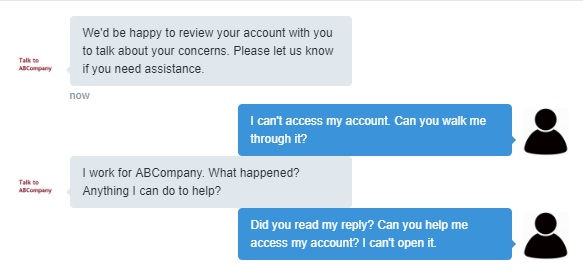
Solution: Using chatbots is more common nowadays, but it would have been more effective if the bot redirected the customer to a real person after the initial greeting. This would’ve solved the problem faster and given the customer a smooth experience.
Failing to inform customers you need time to resolve their issue
Tech support specialists aren’t always available to address a problem right away. Maybe they’re on break or dealing with internal tasks. But this shouldn’t be an excuse to leave your customer hanging.
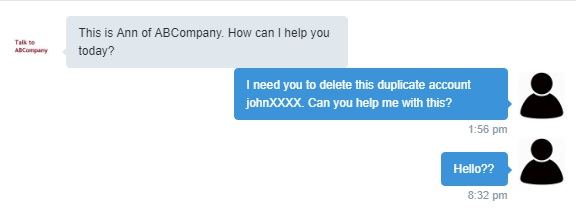
Solution: If the tech support needs time to look into the issue, a response like “I need a few moments to resolve this issue. Do you mind holding on while I look into it? Really sorry for this inconvenience, [customer’s name]!” You can also ask the customer to leave their contact information followed by: “If you’re in a hurry, I’d be more than willing to email you with an answer.”
Not letting go of customers
It’s sad to see your customers go. But when they’ve made the firm decision to end the contract or unsubscribe from your services, the best approach would be to provide them a great service until the very end. Below you’ll see a clingy representative who refuses to give up on the customer.
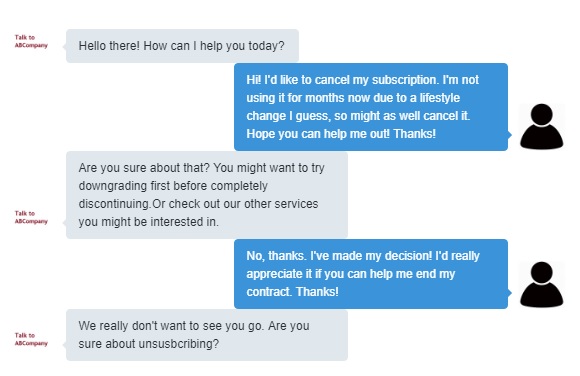
Solution: When a customer decides to discontinue their relationship with your company, it’s best to give them what they want. You’d want to keep the conversation professional yet friendly enough to comply with their request and bid them goodbye. Because the last thing you want to do is make them feel like they’re being taken hostage.
Taking complaints personally
You can’t please everyone. That’s the hard truth. You get compliments and complaints. If a customer didn’t like your service and takes their frustration to social media, respond professionally.
Here, you’ll see a brand taking a blow personally: @mentioning the complainant along with a defensive and incompetent message—on a social media channel—where things like these go viral quickly.

Solution: No matter how unsightly and unpolished the complaint is, it’s best not to stoop down to that level. There are cases where it’s better to stay silent than say anything at all. And if you’re ever going to respond, remember to always keep your words chewy and sweet, in case you have to eat it afterward.
A customer mistakes you for another company
Customers make mistakes, too. This isn’t that big of a deal and when it does happen, see it as an opportunity to win their service.

Solution: Instead of snubbing the customer or simply saying “Sorry, wrong company!”, be a good Samaritan and point them to the right direction.
For example, if someone contacted us, a software development company, thinking we’re a kindergarten school or a learning school (for some reason), we would respond like this:
“Hi, [customer;s name]! We’re afraid you reached out to the wrong company! We’re a software development company based in Delaware helping companies streamline their ideas. You can find [Intended Company] here: [link]. Let us know how we can help you in the future!”
Undertrained support representatives
Some bad tech support experiences stem from undertrained support representatives. If the negative experience causes the customer to share it online, like what happened to Amazon a few years back, this can hurt the brand.
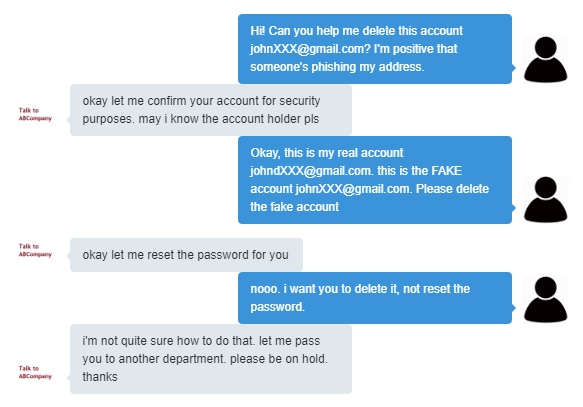
Solution: The best prevention to this is dealing with it early in the process. Make sure that you hire a reputable outsourced tech support team that are trained in their field. Also, encourage your support team to regularly exercise their knowledge about your brand, services, and products. Enlighten them about their responsibilities as well as the functions of other departments. So, if they encounter an inquiry beyond their capacity, they know who to coordinate with.
Lack of empathy
Empathy is a soft skill that is difficult to teach. When a customer reaches out to you asking for help after some kind of tragedy struck them, the least you want to do is stress them even more.
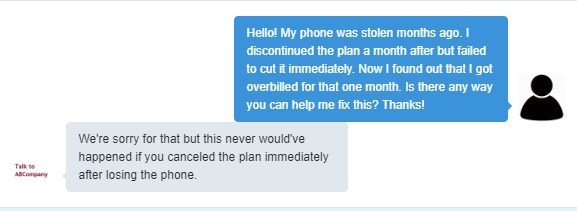
Solution: You want to treat your customers with compassion. For cases such as this, you may offer to review suspicious activities from their account and provide them with the best help you can.
Asking the customer to switch channels
You may have different channels where customers can contact you. But if one decided to reach out via your website’s live chat, and you ask them to send an email instead, then you’re on the running for bad customer service.

Solution: If a customer reaches out via phone or however method they choose, respect that decision. It’s their personal preference. If the issue can be resolved through that channel, then walk them through it via that same platform.
Irrelevant upselling attempts
Customers get turned off at the sight and sound of inappropriate attempts at selling them other products or services.

Solution: They already contacted you due to service interest or request, which means your brand already got their attention. You obtained a new customer! So answer their inquiry directly. Is your monthly subscription plan a fixed price? Yes, or no?
Making the customer feel stupid
You should never make your customer feel stupid or at fault. That’s a recipe for disaster.
In such cases where the customer is at fault or simply not looking hard enough to find solutions to their problems, go for an empathic and friendly approach.

Solution: Instead of going the passive route like the example above, try resolving the issue at hand like this:
“Hi, [customer’s name]!
Thanks for raising this to our attention. The new interface got me confused, too, at first, so no worries! On the upside, I’ve found the way around it by [explain the solution].
I hope this helps! Don’t hesitate to reach out for further questions.
Cheers,
Angel – Support Rep”
Wrapping Up
Not all customers are created equal. Which makes excellent customer support a vital facet of your company. It’s the one aspect that reaches out to your customers; it’s the voice of your brand.
Outsourced technical support not only helps your business cut back on IT costs but also saves you valuable time while improving customer experience. You can focus all your attention on growing your company, and your tech experts will handle streamlining your operations and keeping your customers satisfied. That’s what having a great tech support team is all about!
Learn more about the future of technical support outsourcing or send us an inquiry today!
The Future Of Technical Support Outsourcing: Top Trends And Things To Know
2018 is coming to a close, and most people live, breathe, and eat the Internet. It has empowered consumers to perform a lot of tasks that previously took a lot of time to do, such as shopping, learning, banking, and more. The world has become a smaller place because of this, as the internet allows people all over the world to meet at a common place: online.

To keep up with the needs of the people, businesses have also migrated to this space. Naturally, each company aims to provide the best products and solutions for consumers globally.
In an ideal world, business operations go smoothly and customers never have any problems or issues at all. Sadly, we’re not living in that world. If your website, e-commerce store, customer support system, or any other online channels break down, various aspects of your business could be compromised. It could even create a negative impression with your consumers or hurt your sales.
So, in a world connected by the internet, social media, and smart devices, it’s in almost every business’ best interest to invest in technical support outsourcing. It’s more than just the digital version of calling a plumber to fix your leaking pipes.
Tech Support Outsourcing at a Glance
Companies need tech support for a variety of reasons, and the core focus of the support will depend on what their priorities are and the industry that they operate in. Here are some of the most commonly outsourced tech support functions and how they add value to a company:
Data security – Secure data servers are essential for the business as well as their consumers. For one, company data may contain business plans, financial plans, and any or all tactics that companies use to grow. This is top secret information that should not fall into other people’s hands. On the other side, there’s sensitive information that customers entrust businesses with (credit card details, residential address, etc.) that should also be protected at all times.
Automation – Processes run faster and more efficiently when things are automated—whether it’s payroll, marketing, or inventory management, analyzing and improving the processes that can cut down operation times is crucial.
Customer service – In the age where the customer is king, it’s absolutely essential to add value to the customer experience wherever possible to stand out from the competition. Customer service and support play a huge role in defining the overall customer experience quality. And although it might not directly affect business growth, it more than makes up for it by fostering trust, loyalty, and advocacy.
Software Application Development/Maintenance – The digital age has brought about an increased number of software projects, which can be costly to develop in-house. Outsourcing app development and maintenance helps reduce overhead costs associated with software implementation and provides the necessary technical expertise to provide high service quality.
Cloud services – The usage of cloud services has been commonly associated with Software as a Service (SaaS) and Platform as a Service (PaaS) businesses. This involves applications that are hosted by the vendor and made available to customers through a network (the internet). This approach lets businesses create and implement applications without needing to invest in the underlying infrastructure, reducing costs and increasing overall efficiency.
The Future of Technical Support Outsourcing

Technical Support Outsourcing Market Growth
Earlier this year, it was revealed that the technical support outsourcing marketing is growing steadily. It is set to achieve a CAGR of 8% by 2022, denoting that the industry is about to expand due to new technologies and higher demand from businesses.
Chatbots and Virtual Assistants
IBM reports that 85% of all customer interactions will be handled without human agents by 2020. Customer-centric business practices are here to stay, and chatbots help businesses achieve this. By always being there for the consumer, their questions are quickly addressed in a fast and timely manner.
This opens up new opportunities for the tech outsourcing scene by creating new roles and functions within the industry. IT experts will now have to work with the latest technology like AR, VR, IoT, and the like.
Cloud Services
Cloud services are not just limited to enterprises anymore. Small-to-medium businesses are set to migrate to cloud computing to optimize their business process, increase productivity, and reduce hardware costs. It is projected that cloud traffic will increase 3.7 times by 2020.
This is easily becoming one of the top reasons why companies outsource IT support. It’s efficient, cost-effective, and these days, they’re a business staple.
Emerging Markets
IT services are commonly outsourced in India, Malaysia, and the Philippines. In the coming years, this is set to change. Studies suggest that new markets in Vietnam, Colombia, and the Czech Republic will compete with existing markets in offering the best and affordable tech support. This signals that demand is rising, and the tech support outsourcing industry is growing.
Augmented Reality
The adoption of AR can change the tech support industry as a whole by allowing remote teams to help each other more effectively. A great example is Porsche’s AR program Tech Live Look, which allows their tech experts in Atlanta to help on-site mechanics solve issues in various dealerships. They were able to cut down service time by almost half and communicate with other team members more seamlessly while in different locations.
Predictive Analytics
Data has gotten smarter with predictive analytics. Benchmarking and calculating performance improvements will become more manageable as new tech can now analyze past metrics, customer behavior, and service outcomes. This will allow businesses to focus on their ops and keep all teams aligned with their goals.
Rising Demand for Cost-Effective Solutions
Having onsite technicians can burn a hole in a company’s wallet. Outsourcing has long been proven to help lessen that cost, and still allow businesses to provide high-quality support internally and to their loyal customers. The rising demand for this service creates a bigger market share for the tech support outsourcing industry.
Network Security
A 2017 Enterprise IT Services Survey notes that networking security is the number one priority of digital businesses. Almost half (47%) of the enterprises surveyed mentioned they outsource data security more often than any other IT service.
With the recent data breaches from major digital companies (i.e., Facebook and Google) enterprises are now compelled to focus on corporate and customer data. IT outsourcing contracts will include specific clauses to prevent data breaches and manipulation.
Customer-centric Servicing
Automated customer service is not limited to time zones or public holidays. This allows companies to deliver round-the-clock customer service and resolve issues at a faster rate. In effect, this can increase brand loyalty.
Online Reputation Management
Companies, whether digital or not, all have an online presence. They quickly realize how pertinent having social reputation management is to their name, whether they tap social media, online PR, or SEO services from their outsourcing partner.
AI and Robotic Process Automation (RBA)
RBA will continue to lower the cost of outsourced tech support services. Companies will prefer vendors that can provide this versus those that can’t. This makes use of AI workers and robots to automate common and repetitive software development tasks for increased process efficiency and cost-savings.
Adopting Emerging Technologies
With the rise of the Internet of Things (IoT), blockchain, and machine learning, among others, tech systems face a lot of advancements and updates at a much faster pace. Outsourced tech support agents are usually the best people companies can approach, as they are always updated with the latest tech buzz and innovative software.
Customer Identity and Access Management
CIAM software can provide a seamless cross-channel customer experience. It’s a rich database containing all information about your buyers. With this, both IT teams and managers identify the best way to market to customers. Yet another function businesses are looking to outsource.
Closer Relationships with Managed Service Providers (MSP)
The search is on for professional and loyal IT teams. Managers are now keen on the idea of having Managed Service Providers as consultants and business partners, further illustrating the importance of tech support for organizations.
Complete Integration from Managed Service Providers (MSP)
Companies prefer to have one MSP providing all their outsourced IT functions. In line with making MSPs business partners, this will allow for seamless integration, so that all business functions can work together in sync.
Final Thoughts
Thanks to our increasingly tech-filled world, IT services aren’t going out of style anytime soon. Effectively managed tech support and services can pose a lot of benefits for your business, from increased manpower and lowered costs to higher customer satisfaction and retention rates.
With the rising demand and advancing technology, the tech support sector is definitely poised to continue growing rapidly over the next few years. It’ll be interesting to see what other developments come next!
Contact us today to learn more about what the future of technical support outsourcing means for your business!
Will bots really replace the human customer support role
Perhaps it took longer than expected, but the rise of the machines is now at hand. Artificial intelligence is fast becoming more advanced and is now being used in a host of applications. It’s changing the technological landscape as we know it, bringing us closer to Cyberdyne System’s Skynet computer.
But let’s not get ahead of ourselves, folks. We’re currently working on and perfecting AI functions that can help us humans do simple, labor-intensive ‘narrow’ tasks across different industries. A neural network controlled by a sentient AI computer is still far from reality, but with the way things are going, it’s not impossible.

The progress we’ve been making in the field of artificial intelligence has been no less impressive. Machines can now perform predictive analysis, deductive reasoning and natural language understanding, which are all needed in understanding and predicting what the user needs or maybe offer recommendations for the next action.
Now that we’re taking the development of AI in the right direction, it is found to have good use in the field of customer service. Chatbots are now all the rage in the tech world, simulating conversations with people to address their questions or perform simple tasks. These bots are now booming not only in text conversations but in verbal exchanges as well. Yes, we’re looking at you, Alexa.
AI’s Role in Customer Support
Businesses need a fast and efficient customer support service to address all their customers’ concerns. This helps them forge good relationships, making it an essential factor in running a successful business. And with chatbots now taking the place of humans in online conversations, they are revolutionizing the customer service industry.
Chatbots automate conversations with real humans by delivering the right responses according to how they are programmed to do so. With language processing now an integral part of AI, conversations are more seamless, as if you’re having one with a real human being. Advancements are set to further make it harder to discern if you’re chatting with a person or perhaps Threepio.
Many companies embrace a chatbot’s functions as a means to complement or even reduce the need for call centers. As human-to-human chat conversations become a thing of the past, this will significantly reduce operating costs.
For now, chatbots are used to collect basic information, with the more advanced versions providing resolutions for increasingly more complex issues. This speeds up response times and frees agents for more challenging work that requires a more advanced brain. Yes, the one responsible for creating chatbots in the first place.
Why Bots are Here to Stay
The bots we’ve read about or seen in fiction were made to serve humans, and their purpose hasn’t changed one bit in real life. Now that AI-driven chatbots are being extensively used in the field of customer support to perform repetitive and simple tasks, they are proving to be invaluable.
Despite being relatively basic, bots can help relieve humans of the grunt work, which can streamline any process and make things move along faster and a bit easier. This saves loads of time and money for the company during the technical support process. Here’s how it works:
Process Efficiency
When calls come in, human agents go through the motions of collecting information from the concerned customer before they proceed to address the issue. AI-driven bots can streamline this step and cut the time it takes to complete this task, so a human agent can resolve the issue at hand. Although support ticket qualification is a fairly simple task, automating it can result in huge time savings.
Cost Efficiency
When processing time is lessened to a considerable degree, more calls can be processed within the day. This significantly decreases the operational cost by taking in more customers who need help in a single day. When AI becomes more advanced, pretty soon there will be more stages in the operation that can be taken over by bots. This will allow humans to focus on more difficult tasks and become even more cost-efficient.
Better Customer Experience
Once the process is streamlined to a point where your service addresses all customer concerns in a reasonable period of time, you will leave them feeling satisfied with the whole interaction. The bots help make the process faster, and the human touch becomes more focused on a customer’s needs. All this leads to a better customer experience, creating a competitive advantage for your brand.
Timeliness
Machines are all about speed and precision. They help cut work time to achieve results faster, which is the reason why AI-driven bots are increasingly becoming popular. Additionally, the risk of human error is basically non-existent. So, when it comes to menial tasks, bots are faster and more accurate – it really isn’t much of a competition.
But Will They Replace Humans?
With AI being able to handle increasingly sophisticated tasks, many believe they’re a growing threat to us humans. People are under the impression that they will start taking jobs away from us, and before we know it, they will gain sentience and start making slaves out of us ‘fleshies.’ That is one dystopian future nobody wants to become a reality.
But before we get in over our heads, AI-driven machines aren’t about to take us out. We are still at a stage where we are finding ways to make machines help make our jobs easier. And regardless of how far we’ve made them more advanced, there will always be a need for a human touch.
Humans take a lot of things into consideration when making an important decision. There are intangibles involved, such as emotions and creativity, which they combine with logic to arrive at the best outcome from any situation. On the other hand, bots based theirs purely on data and may be limited in scope.
Final Note
The advancements happening in AI technology are something to look forward to, but for some, they could be a threat. Even tech magnate Elon Mask has expressed concerns about AI warning us that it may create an ‘immortal dictator that we can’t escape from'.
But fret not! There won’t be any T-1000s hunting us down anytime soon. The whole point of AI-driven machines is to help us humans from labor-intensive tasks that can shorten the process. This makes the combined efforts of AI and humans more effective, with humans still overseeing that everything is going the way as planned.
Your job is safe. For now at least…
Looking for help with your technical support initiatives? At Intelligent Bee, we've got a team of experts (with the human touch) ready to provide flexible solutions at competitive prices. Contact us today!
Technical Support Scams To Watch Out For (And How To Spot Them)
Technology has helped the world in many ways, but there’s no denying that there’s a dark side to it. For instance, phones, computers, and the internet can be exploited by fraudsters to deceive unsuspecting users into giving up personal information, and to some extent, their properties too.

Technical support scams do just that—they fool the unaware into thinking that there’s something wrong with their system and equipment, make them contact an unknown number, and steal personal information as victims are unknowingly being tricked. There are also instances wherein the scammers are the ones who call the user.
Tech Support Scams in Numbers
These types of cons are nothing new, but admittedly a lot of people still fall for it, especially since criminals keep finding new ways to conduct their fraudulent activities. A 2016 survey sponsored by Microsoft found that 2 in 3 people have experienced a type of tech support scam within the past 12 months; 1 in 10 have lost money.
In 2017, Microsoft’s Customer Support Services received 153,000 reports of such scams from 183 countries, with a 24% rise from the previous year. Approximately 15% of those who reported lost an average of $200 and $400.
Virtually anyone who owns a connected device is vulnerable—even though Microsoft is often namedropped by tech support scammers (with the company receiving 12,000 complaints every month globally), having a device other than Windows cannot protect a person either, as these deceptive acts can also fool those who use MacOS, iOS, Android, and other operating systems.
In terms of age, scams reported to Microsoft tend to be from older customers. The US Federal Trade Commission (FTC) has found evidence that the elderly are more impacted by fraud as compared to the younger generations. However, it was also found that millennials (ages 18–34) are more likely to continue with a fraudulent tech offer compared to other age groups.
The underlying cause, though, is that many people are fooled into thinking that they are working with a legitimate business, whether that user is old or not.
The Fallout
As mentioned, tech support scams are designed to trick users into believing that their devices are compromised. The frauds will then coerce the user into purchasing unnecessary support services. In some instances, they will request access to the user’s device by getting sensitive information or making them install dubious apps that can remotely retrieve the details they need.
In December 2014, when tech support scams hit mainstream media, Microsoft sued several companies for unfair and deceptive business practices and trademark infringement. Later in 2015, the FTC announced the shutdown of several tech support scammers that pretended to be associated with Apple, Microsoft, and Google, and stole a combined $17 million from consumers.
In another case, the FTC had to give out partial refunds to around 37,000 victims of a fraudulent tech support company named Inbound Call Experts. This is after the company tricked consumers into buying unnecessary products and services by pretending that there is something wrong with their computers, all of which happened from April 2012 to November 2014.
No matter how big a business is, taking a legal action remains to be an arduous process. In this instance, Microsoft had to deal with the consequence of additional costs to fix issues that the company didn’t intend to put themselves into.
Despite Microsoft proving their innocence, there’s no denying that negative news like fraud can have a lasting impact on consumers. Those who don’t know better would likely continue to associate Microsoft with the fraudsters.
Spotting the Sham
The best way to avoid falling into shady acts is knowing what constitutes a tech support scam.
Unsolicited Calls
This outdated yet effective sham is done through cold calls. The fraudster who claims to be from a reputable company will call the target and say that the company found something wrong on the computer.
Microsoft and other companies often employ outsourced tech support, but no tech company will ever reach out to the consumer, even if it’s in the name of public service. Microsoft’s security bulletin reads, "Microsoft will never proactively reach out to you to provide unsolicited PC or technical support. Any communication we have with you must be initiated by you." That means users will only receive a call if they request it.
In addition, caller IDs can be manipulated to show only the company name, but not the number, so it’s not reliable either. Hang up if this ever happens, and never give any personal information.
Phishing Emails
It’s easy to fall for a phishing email because it does look like a message from a legitimate source. But once the target clicks and visits a malicious link included for a fake site that the scammers control, they will then be fooled into filling out a form with their sensitive information like email password, credit card details, bank account number, etc.
Again, the best way to avoid this practice is to ignore it (and delete the email, too) and never reply. Don't click any of the links on it, either. Remember to change passwords regularly as well.
Sketchy Advertising or Pop-ups
Pop-ups appear when users are browsing the Internet and visit a website that contains suspicious links that, when clicked, will redirect them to a site hosting the pop-ups. These pop-ups can get so intrusive that it can become difficult for the user to close them as they appear.
Often, these pop-ups will contain a message stating that the computer is infected or that it will be locked down, blocking internet access, or making it unusable. The message will usually be accompanied by a phone number which the user can contact to fix the problems, or so it claims.
First off, you should know that legitimate IT support groups will not use pop-up messages to alert you of issues, so it’s best to ignore these messages. Aside from that, scrutinize the message and look for poor spelling or grammar and lousy imagery, which would usually imply fraud. A quick Google search can also support the legitimacy of the contact details included.
Confusing Search Results
Interestingly enough, fraudulent companies also have budgets to use legitimate paid search channels to advertise their fake support services. To be on the safe side, study the website chosen before retaining a company’s services and always keep an eye out for trust signals.
In Conclusion
As long as technology continues to advance, so will the swindlers who continue to take advantage of users, especially those who aren’t well-versed in the technological aspect. The responsibility remains with users and consumers, as they need to stay vigilant in this thriving yet perilous age of information security. Tech companies, meanwhile, should do their part and ensure better protection for their clients.
Experience has it: 10 best practices for outstanding customer support services
Outsourced customer support is the future. Whether you’re a startup or a company with more than 100 employees, the need for customer support is rising due to the fact that products aren’t perfect, yet we aim for perfection when it comes to our services. “How can you remain on top of the game in the field of customer support?” is a question we hear a lot lately and we wanted to share with you 10 best practices that we learned in 7 years of experience with partners such as SendGrid and Cloud Elements.
Before we start, let us underline once again the idea of a customer support department. Whether it’s in-house or outsourced, the customer support department of a SaaS company should reduce customer churn. The product or service can be outstanding, yet the technical support that you are offering is crucial in your relationship with your customers. After more than 7 years of work with SendGrid and Cloud Elements, we gathered 10 best practices that will set you ahead of your competitors.
1. Hire the best people to represent your service/ product.
We can all agree that your agents are your brand’s diplomats. You form and maintain connections through them with the customers that will keep you in business. Hire and retain experienced people and exceptional outsourced customer support will follow.
2. Offer customer support on more than one channel, including live chat.
Instant communication channels can save or ruin the image that a client has about your product/service. When it all comes to customer’s expectations, the best way to offer a quick and helpful answer is through chat. Make it easy for customers to interact with you and don’t keep them waiting.
3. Encourage self-service.
More than 67% users prefer a self-service support over speaking to a company representative. It’s a fact that can be turned around in your favor once you create a FAQs page with content that answers common questions that customers usually come up with. From a FAQs page to regularly posting basic troubleshooting articles on your website, encourage self-service and you will receive a better feedback for product or service enhancements.
4. Attitude is everything.
When working on a customer support service, your positive attitude can turn a problem into a solution in no time. You know that in business, you never get a second chance for making a first good impression. Have the customer in mind and deliver responsive and personalized support.
5. Listen to customers.
The key to effective communication is active listening. Even when the customer is upset or angry, your customer support agent should treat him cordially, eager to give advice and to find a real-time solution. If you’re active listening to your customers, not only you will find more about the issue encountered and you will give better advice, but you will leave an imprint in your customer’s mind.
6. Ownership can change an issue into a solution.
Empower your representatives to make decisions in real time and to act upon customer’s best interest. If the issue needs more information in order to be classified as resolved, your customer support agents should follow up and address the issue further on until it’s resolved.
7. Honor your commitments.
Do what you say you will do. Earning trust and respect are key-points in the relationship between a company and its customers. Tell your customers exactly what they can expect from you and then go hard to exceed those expectations. That way, your customers will see that you’re willing to go the extra mile.
8. Set KPIs.
It’s important to always measure the success of a customer support team. For that, use KPIs and metrics that should be defined as parameters in judging the performance of a customer support agent or a technical support team.
9. Regularly train your agents.
Properly training your representatives can give them the power to make on-the-spot decisions that can change an issue into a solution. Ensure that they completely understand the product and the process and conduct refresher training sessions when there are any product enhancements. A well prepared customer support agent is a key point in maintaining your customers happy.
10. Ask for feedback.
A feedback at its time can change the path of your company. A study by The George Washington University from Washington, DC, shows that users will share their experiences with 8 out of 10 persons they meet. Ask customers to review your service after each session in order to find out if it was helpful or what aspects you should change.
Customer support in this century is the secret weapon of every business that respects itself. Without a customer support department, you can’t have a business that it’s focused on the customer, therefore you can’t really grow. For an outstanding customer support service, follow these best practices that we gathered in 7 years of experience.
Also, in case your company is looking to outsource customer support, go ahead and contact IntelligentBee for a proposal.
We would love to hear about your experience and how they worked for your business.
The Difference Between Customer Support And Customer Success Teams
When we talk about your business product or service, there is no doubt that both support and success teams are considered as essential assets for the entire customer lifecycle. Since customer support and customer success are often intertwined, we think that is critical to define and understand their differences and roles, especially when your company’s output is based on a certain tech infrastructure.
Customer support – A necessary way to be there for your customers.
Dedicated support teams pursue to ensure customer satisfaction through ongoing technical support for a certain product or service. These kinds of teams solve customer’s challenges, questions and concerns regarding individual issues and provide technical guidance. For a better understanding, we should define a couple of specific traits.
Removes obstacles
Regardless of the customer support channel – email, chat or call – the team in charge solves their problems as soon as customers submit a ticket or send an email, not before. Thus, the role of customer support is to meet their needs in a reactive manner, meaning that whenever an issue emerges they take care of it. In this way, a support team removes any kind of obstacles when it emerges in customer’s direct interaction path by providing necessary resources such as documentation or self-service portals.
Focuses on cost
The number of favorable customer experiences is inversely proportional to financial losses. In other words, based on Nicereply point of view, if a support team provide efficient solutions for customer’s problems, the churn rate, which means here the annual percentage at which customers stop subscribing to a service, will be reduced. However, support teams aren’t strictly a centered-cost department, as originally built, they can also impact revenue by advising on common reasons for churn or identify upsell and cross self-opportunities in their conversations with your business customers.
Has short-term objectives
According to Hubspot, support interactions are transactional which means when a customer submits a certain issue or question, those are solved by a support assistant – and may have in view immediate technical or usage issues. After all, the main purpose of support teams is to solve specific issues as quickly as possible in order to drive customer satisfaction, which is the main baseline for success teams.
Customer success – The next step in scaling customer experience.
From Gainsight perspective, customer success manages company-customer interactions and aligns client and vendor goals for mutually beneficial outcomes. Success teams influence revenue through their proactive actions in order to accomplish long-term objectives, but we will talk about all of these attributes below:
Uses proactive strategies
The main objective of a success team consists in initiating conversations with your customers before they contact you. Therefore, they have to be proactive, meet their needs, anticipate them and identify opportunities to solve problems that they are not yet confronted with, but they might be. Identifying these solutions in advance must be based on the company’s long-term objectives. Their job is to make sure that customers understand the full potential and value they can achieve from your product/service. In other words, success teams ensure insights-access for users regarding the most efficient way to use your solution and adopt it on a long-term.
Focuses on revenue
In this context, when we talk about scaling your business, customer success teams play their main role. They focus less on technical issues and more on the aspects that are directly related to business development. So they drive expansion via churn-reduction as in decreasing the number of unsubscribed customers and up-selling, cross-selling, referrals techniques in order to promote your business solutions.
Customer Success provides a whole mechanism not only for uncovering upsell and cross-sell opportunities but also for gaining advantage from them. Besides that, it’s the most desirable way to initiate reduction, helping subscription growth for a certain product or service.
Has long-term objectives
Success team’s interactions don’t have an end-point. As we mentioned earlier, they look at the entire customer’s process lifecycle in order to solve universal adoption issues and other common narrows that prevent users from achieving their goals. Moreover, as Gainsight believes, ensuring customer success brings about a significant positive impact on businesses as they focused on increasing retention, repeated purchases or lifetime value.
Different roles, same team
To conclude, support and success teams provide services for customers and help them generate value for your company. Both of them focus on successfully integrate the product or service in your users’ lifecycle with each aid, improving retention, boosting value, and increasing advocacy. The best businesses succeed in bringing support and success together, leveraging their differences to consolidate this entire process of removing obstacles that prevent your business customers from achieving their goals.









